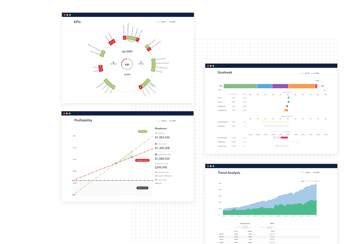10 Effective Ways to Improve Cash Flow
Every business needs to have more cash flowing in rather than out of it in order to stay afloat, pay staff and bills, and hopefully make a profit. But cash flow can fluctuate and it’s important to know how to improve cash flow rather than simply relying on revenue growth. It’s not always possible to instantly sell more – but there are other methods of improving cash flow that you can adopt to help alleviate the situation quickly.
This article covers the impact cash flow problems can have on your business, how to avoid cash flow problems and 10 ways to improve your cash flow.
Takeaways on how to improve cash flow
- By the end of this article, you'll understand how to improve the flow of cash into and out of your business
- We'll share some tips on how to improve the accuracy and detail of your cash flow forecast with some expert advice
- You'll discover how cash flow forecasting software gives you greater insight and supports business decisions
- We cover how implementing a cash flow forecasting system helps you achieve complete transparency and accurate, up-to-date forecasts
- We'll discuss the benefits of choosing an integrated finance management software for cash flow forecasting functionality
How to improve cash flow in 10 different ways
So, how do you improve cash flow with all of the above information in mind? There’s no shame in having cash flow problems from time to time. Let’s not forget that the world of business is an uncertain one with no guarantees. To get your business back on track, and avoid the issues that negative cash flows can cause, check out these 10 ways to solve cash flow problems.
- Actively encourage customers to pay on time
Although it’s certainly common (and simpler) to offer every customer the same terms, you could be missing a trick. Differential pricing, early payment bonuses and late payment penalties are all proven methods for improving cash flow. You might need to ensure your accounts payable systems can support the process effectively, but in the long run you should see some improvements. - Look for staff cost savings
When payroll is such a large part of any business outgoings, it’s also a good place to look for potential savings. Consider whether some staff might want to go part-time for example. What does your temporary staff bill look like – and could you make savings by taking on employees rather than paying for expensive temps? Even encouraging more to work from home can have a knock-on effect on heating, lighting and space rental costs for example. - Manage your stock and suppliers
‘Just in time’ (JIT) processes for managing stock are well established in the manufacturing industry and offer food for thought for other sectors to consider too. One of the key elements of efficient JIT management is having a good system in place to ensure that the inventory is always tightly managed in real time so you never have too much or too little to meet your needs. That usually means decent stock management technology. At the other end of the spectrum, you might find it’s worth just auditing your stock regularly and talking to your suppliers to see if you can spread out orders into smaller deliveries – and thus spread out your payments into smaller chunks over a time period to help improve your cash flow. This is simple to do with cash flow forecasting software. - Consider the impact of new assets and investments
If you’re on a growth pathway with a detailed business plan, you might have capital expenditure or investment looming. Before committing to any new expenditure, make sure your cash flow forecast and cash cushion are robust enough to manage if circumstances change. There’s not point in sticking to the business plan if the stretch subsequently puts your stability at risk. - Check your accounts payable terms
Do you offer standard 15-day or 30-day payment terms for your customers? How does this compare with others in your sector? It’s worth taking some time to assess if your accounts payable terms and procedures are still in step with your industry. Your competitors might for example be taking part payment up front and the balance on completion (which of course is great for cash flow). Or you might be the only one left offering generous payment terms and find that others are expecting and receiving their payments in less time than you are used to. If there’s no incentive to pay you quickly, why would your customer bother to? - Cut needless spending
It might sound obvious but as one of the ways to improve business cash flow, this is one of the most effective ways to make a difference quickly. Ask your managers across the business to find savings in their departments. Some companies find that asking employees for their ideas is a good way to discover new savings that haven’t been thought of before. Cost-cutting doesn’t always have to be a negative – sometimes it can be a way to recognise individuals for their innovative ideas. - Consider leasing rather than buying
As well as being tax deductible, leasing the vehicles and equipment you need to run your business can also be quite a lot cheaper than buying outright. An additional benefit is that you can then replace with newer kit after a set period too. - Make it easier for customers to pay you
The days are long gone when business customers sent a cheque in the post. Now there are such a huge variety of ways to pay for goods and services from BACS payments to contactless, digital currency, mobile payments, and third party payment platforms. So consider how easy it is for your customers to pay you. You can even ask your customer base what payment methods they would like to see to make their lives easier too. - Try invoice factoring
Many businesses use invoice factoring as a means of accessing cash to alleviate temporary cash flow issues. An invoice factoring business will ‘buy’ your outstanding invoices from you for a proportion of their value, thus providing you with cash. They then collect those payments on your behalf within a set time period. The balance collected is then paid to you, minus the fee for the factoring company. - Stay up to date on the details
Staying on top of your cash flow means keeping right up to date on the detail. Your cash flow forecast should provide the information you need to see clearly what your cash flow position is and how it spans the next 12 months. Read on to find out how to improve your cash flow forecast.

How to improve cash flow forecast
Measuring the flow of cash going into your business (from sales, investors etc) as well as out of your business (to pay staff, suppliers, buy stock etc) is the data that constitutes a cash flow forecast.
What can make a difference however, is how much detail and how accurate your cash flow forecast is. Improving your cash flow forecast and ensuring it is kept completely up to date will benefit your business in multiple ways.
- Provide greater insight to support business decisions
- Build stakeholder confidence that cash flow is robust
- Show early signs of potential issues
One proven way to improve cash flow forecasting is to use software to crunch your numbers. There are lots of cash flow forecasting solutions available so it’s important to consider the size and complexity of your business before choosing your provider.
Comprehensive finance software packages such as Access Financials include cash flow forecasting functionality along with the full range of finance tools. Many medium-sized companies use this to improve their business cash flow thanks to the key insight it provides.
Further reading: How to do a cash flow forecast.
Improving cash flow with a cash flow forecasting system
As we’ve seen, the key to improving cash flow is having complete transparency across your business data, and ensuring your cash flow forecast is accurate and up to date.
Our cash flow forecasting software brings together powerful reporting, fast cash flow forecasting and actionable financial insights into one solution. You'll be able to predict your future cash flow easily, allowing you to keep ahead of your business' performance and make great decisions for the future.
To see the cash flow forecasting software in action, book a demo so our finance specialists can show you all the great features.





